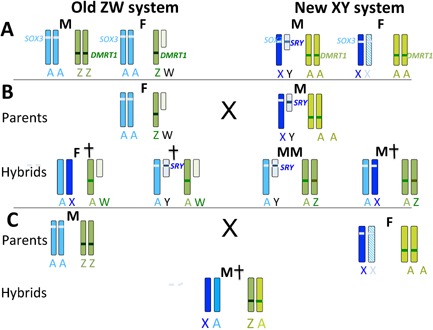Figure 3.

Interaction of ancient ZW and de novo XY sex determining systems. A: In the old ZW system, the male (M) has two Z chromosomes (green), bearing DMRT1. Females (F) have a single Z and a degenerate W. Dosage of DMRT1 determines sex; two copies are required for male development (dark green). Some upregulation of Z genes occurs in females. An autosome (blue) bearing SOX3 (light blue) is present in two copies in both sexes. In the new XY system, with the evolution of SRY (dark blue) from SOX3, the blue autosome has become a sex pair. Males have a single X and a degenerate Y bearing the male‐dominant testis determining gene SRY; genes on single X are upregulated (darker blue). Females have two X chromosomes; one upregulated (darker blue) and one inactive (blue hatching). Gene content of the X has become specialised. The Z chromosome has become an autosome (A, lighter green), losing its dosage compensation and DMRT1 is no longer sex determining (lighter green). B: Matings between heterogametic female (ZW) and heterogametic male (XY) produce hybrid offspring with four combinations of ZW and XY chromosomes, with predicted phenotypes as shown (male M, female F, dead †). Hybrids with two green chromosomes may be male with or without SRY. Only offspring with two blue chromosomes and a single green chromosome are likely to be female. Offspring with both a degenerate W and Y are likely to be inviable, and offspring with two blue chromosomes (an X and autosome) could suffer from dosage problems (too much product if the X is upregulated; too little if it is inactivated). C: Matings between homogametic male (ZZ) and homogametic female (XX) produces offspring with only one combination of sex chromosomes. With two DMRT1 copies these are likely to be male; however, the combination of an X and the original autosome may not be viable if the X is upreguated or inactivated.
